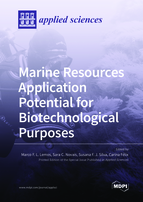Marine Resources Application Potential for Biotechnological Purposes
A special issue of Applied Sciences (ISSN 2076-3417). This special issue belongs to the section "Environmental Sciences".
Deadline for manuscript submissions: closed (10 July 2021) | Viewed by 25430
Special Issue Editors
Interests: biotechnology; bioeconomy; biomarkers; circular economy; stress biology
Special Issues, Collections and Topics in MDPI journals
Interests: biotechnology; marine resources valorization; genomics; biodiversity and ecosystem functioning
Special Issues, Collections and Topics in MDPI journals
Interests: biotechnology; marine resources valorization; microbiology; genomics
Special Issues, Collections and Topics in MDPI journals
Interests: biotechnology; marine resources valorization; food development; natural-based food coatings and films
Special Issues, Collections and Topics in MDPI journals
Special Issue Information
Dear Colleagues,
Blue biotechnology plays a major role in converting marine biomass into societal value and is, therefore, a key pillar for many marine economy developmental frameworks and sustainability strategies: the Blue Growth Strategy, diverse Sea Basin Strategies (e.g., Atlantic Action Plan Priority 1 and 2 and COM(2017)183), the Marine Strategy Framework Directive, the Limassol Declaration, or even the UN Sustainable Development 2030 Agenda. However, despite the recognized biotechnological potential of marine biomass, the work is dispersed between multiple areas of applied biotechnology, resulting in few concrete examples of product development.
Food and feeds, and high-revenue cosmeceutical, pharma, biomedical markets, and others, are increasingly more important for marine bio compounds, which hold a myriad of unexploited uses, as they have often demonstrated to contain molecules with a plethora of bioactivities, ranging from antioxidant, anti-inflammatory, tissue-specific protection, antimicrobial, anti-tumoral, antifouling, and texturizer, among many others.
This Special Issue will cover review articles, short communications and research papers addressing marine resources’ in vitro and/or in vivo biological activities which may present high applicability and potential for industrial purposes.
Dr. Marco F. L. LemosDr. Sara Novais
Dr. Carina Félix
Dr. Susana Silva
Guest Editors
Manuscript Submission Information
Manuscripts should be submitted online at www.mdpi.com by registering and logging in to this website. Once you are registered, click here to go to the submission form. Manuscripts can be submitted until the deadline. All submissions that pass pre-check are peer-reviewed. Accepted papers will be published continuously in the journal (as soon as accepted) and will be listed together on the special issue website. Research articles, review articles as well as short communications are invited. For planned papers, a title and short abstract (about 100 words) can be sent to the Editorial Office for announcement on this website.
Submitted manuscripts should not have been published previously, nor be under consideration for publication elsewhere (except conference proceedings papers). All manuscripts are thoroughly refereed through a single-blind peer-review process. A guide for authors and other relevant information for submission of manuscripts is available on the Instructions for Authors page. Applied Sciences is an international peer-reviewed open access semimonthly journal published by MDPI.
Please visit the Instructions for Authors page before submitting a manuscript. The Article Processing Charge (APC) for publication in this open access journal is 2400 CHF (Swiss Francs). Submitted papers should be well formatted and use good English. Authors may use MDPI's English editing service prior to publication or during author revisions.
Keywords
- Applied biotechnology
- Bioactive secondary metabolites
- Biological assay
- Blue biotechnology
- Marine biomass
- Marine natural products









